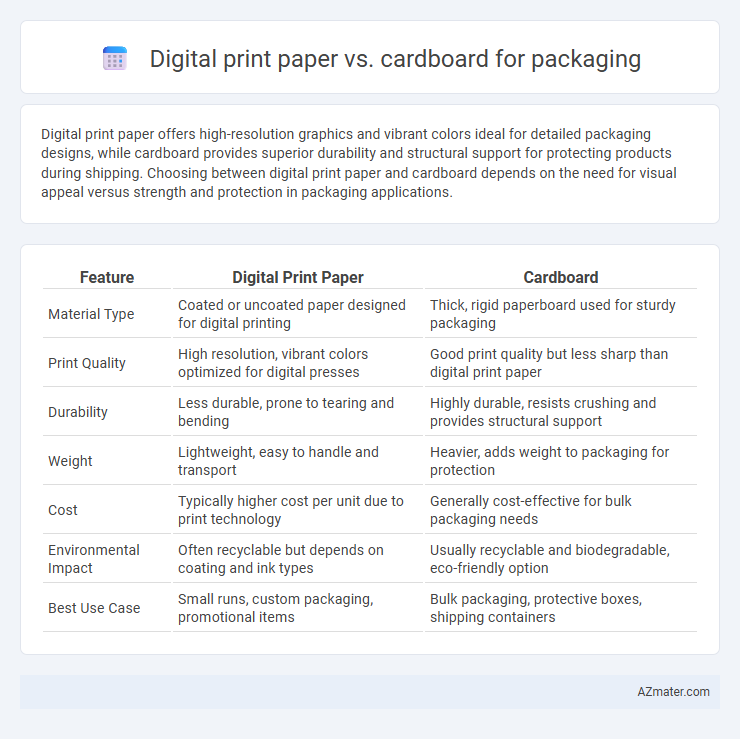Digital print paper offers high-resolution graphics and vibrant colors ideal for detailed packaging designs, while cardboard provides superior durability and structural support for protecting products during shipping. Choosing between digital print paper and cardboard depends on the need for visual appeal versus strength and protection in packaging applications.
Table of Comparison
| Feature | Digital Print Paper | Cardboard |
|---|---|---|
| Material Type | Coated or uncoated paper designed for digital printing | Thick, rigid paperboard used for sturdy packaging |
| Print Quality | High resolution, vibrant colors optimized for digital presses | Good print quality but less sharp than digital print paper |
| Durability | Less durable, prone to tearing and bending | Highly durable, resists crushing and provides structural support |
| Weight | Lightweight, easy to handle and transport | Heavier, adds weight to packaging for protection |
| Cost | Typically higher cost per unit due to print technology | Generally cost-effective for bulk packaging needs |
| Environmental Impact | Often recyclable but depends on coating and ink types | Usually recyclable and biodegradable, eco-friendly option |
| Best Use Case | Small runs, custom packaging, promotional items | Bulk packaging, protective boxes, shipping containers |
Introduction to Digital Print Paper and Cardboard Packaging
Digital print paper offers high-resolution, vibrant images and is ideal for short-run, customized packaging solutions with detailed graphics. Cardboard packaging provides durability, structural strength, and eco-friendly properties suitable for protecting heavier items during shipping. Both materials serve distinct roles in packaging, balancing visual appeal with physical protection depending on product requirements.
Material Composition and Environmental Impact
Digital print paper, made primarily from cellulose fibers with coatings suitable for high-resolution inkjet or laser printing, offers superior print quality but is less durable than cardboard, which consists of multiple layers of paperboard providing enhanced strength and rigidity for packaging. The environmental impact of digital print paper leans towards higher recyclability and biodegradability but often involves chemical coatings that may affect compostability, while cardboard packaging, especially recycled variants, generally has a lower carbon footprint and better end-of-life recyclability due to its minimal chemical treatment and ability to maintain structural integrity after multiple reuses. Choosing between digital print paper and cardboard depends on balancing print quality demands against packaging durability and specific environmental goals such as waste reduction and material lifecycle sustainability.
Print Quality and Customization Capabilities
Digital print paper offers superior print quality with vibrant colors, fine details, and high resolution, making it ideal for packaging requiring intricate designs and photo-realistic images. Cardboard provides robust durability and structural support but may have limitations in achieving the same level of print sharpness or color accuracy as digital print paper. Customization capabilities are more flexible with digital print paper, enabling quick changes, short runs, and variable data printing, whereas cardboard customization often involves longer production times and less intricate design options.
Durability and Protection of Packaged Goods
Digital print paper offers high-resolution graphics and vibrant colors but lacks the structural strength needed for heavy or fragile items, making it less durable for long-term packaging. Cardboard provides superior rigidity, impact resistance, and cushioning, ensuring enhanced protection for products during shipping and handling. Combining digital print techniques with sturdy cardboard results in visually appealing packaging without compromising durability and product safety.
Cost Comparison: Digital Print Paper vs Cardboard
Digital print paper typically costs less than cardboard due to lower material and manufacturing expenses, making it ideal for short-run or custom packaging projects. Cardboard, although more expensive upfront, provides superior durability and structural integrity, which reduces potential damage and return costs over time. Choosing between digital print paper and cardboard depends on balancing initial expenditure with packaging strength and lifespan requirements.
Application Suitability Across Industries
Digital print paper offers high-resolution graphics and vibrant color reproduction, making it ideal for consumer goods packaging, promotional materials, and short-run custom designs. Cardboard provides superior strength and durability, suited for heavy-duty shipping, e-commerce packaging, and bulk product protection across industries like electronics, food and beverage, and automotive. Selection between digital print paper and cardboard depends on packaging requirements such as visual appeal, structural integrity, and cost efficiency within specific industry applications.
Eco-Friendliness and Recycling Options
Digital print paper is generally more eco-friendly than cardboard due to its lower resource consumption and ability to use recycled fibers, making it a sustainable choice for lightweight packaging. Cardboard offers robust recycling options and biodegradability, providing excellent environmental benefits for heavier or protective packaging needs. Both materials support circular economy principles, with digital print paper excelling in minimizing waste and cardboard facilitating efficient material recovery and reuse.
Speed and Flexibility in Production
Digital print paper offers unmatched speed in packaging production due to its direct-to-surface printing technology, enabling rapid turnaround times ideal for short runs and custom designs. Cardboard packaging requires longer setup and drying times, making it less flexible for quick changes or small batches. The flexibility of digital print paper accommodates frequent design iterations and personalized packaging, enhancing efficiency in dynamic production environments.
Visual Appeal and Branding Opportunities
Digital print paper offers superior visual appeal with high-resolution images and vibrant colors, allowing brands to showcase intricate designs and detailed logos that capture consumer attention. Cardboard, while more durable and eco-friendly, often limits the printing quality to simpler graphics and fewer color variations due to its textured surface. Brands seeking premium aesthetics and enhanced customization typically choose digital print paper for packaging to maximize branding opportunities and create a memorable unboxing experience.
Choosing the Right Material for Your Packaging Needs
Digital print paper offers vibrant color reproduction and fine detail ideal for high-quality, short-run packaging with intricate designs. Cardboard provides superior durability, structural support, and cost-effectiveness, making it suitable for shipping, protection, and eco-friendly packaging solutions. Choosing the right material depends on the balance between aesthetic appeal, product protection requirements, and budget constraints to ensure optimal packaging performance.

Infographic: Digital print paper vs Cardboard for Packaging
 azmater.com
azmater.com